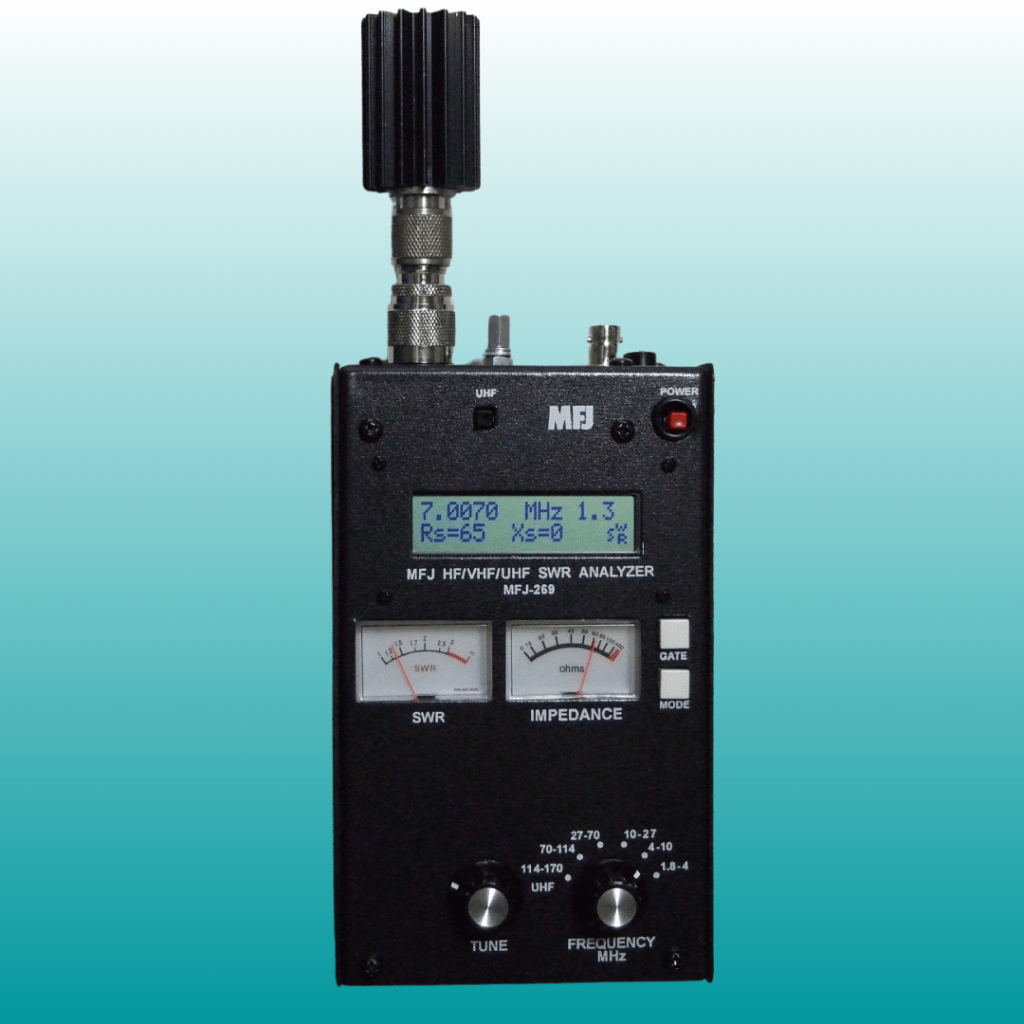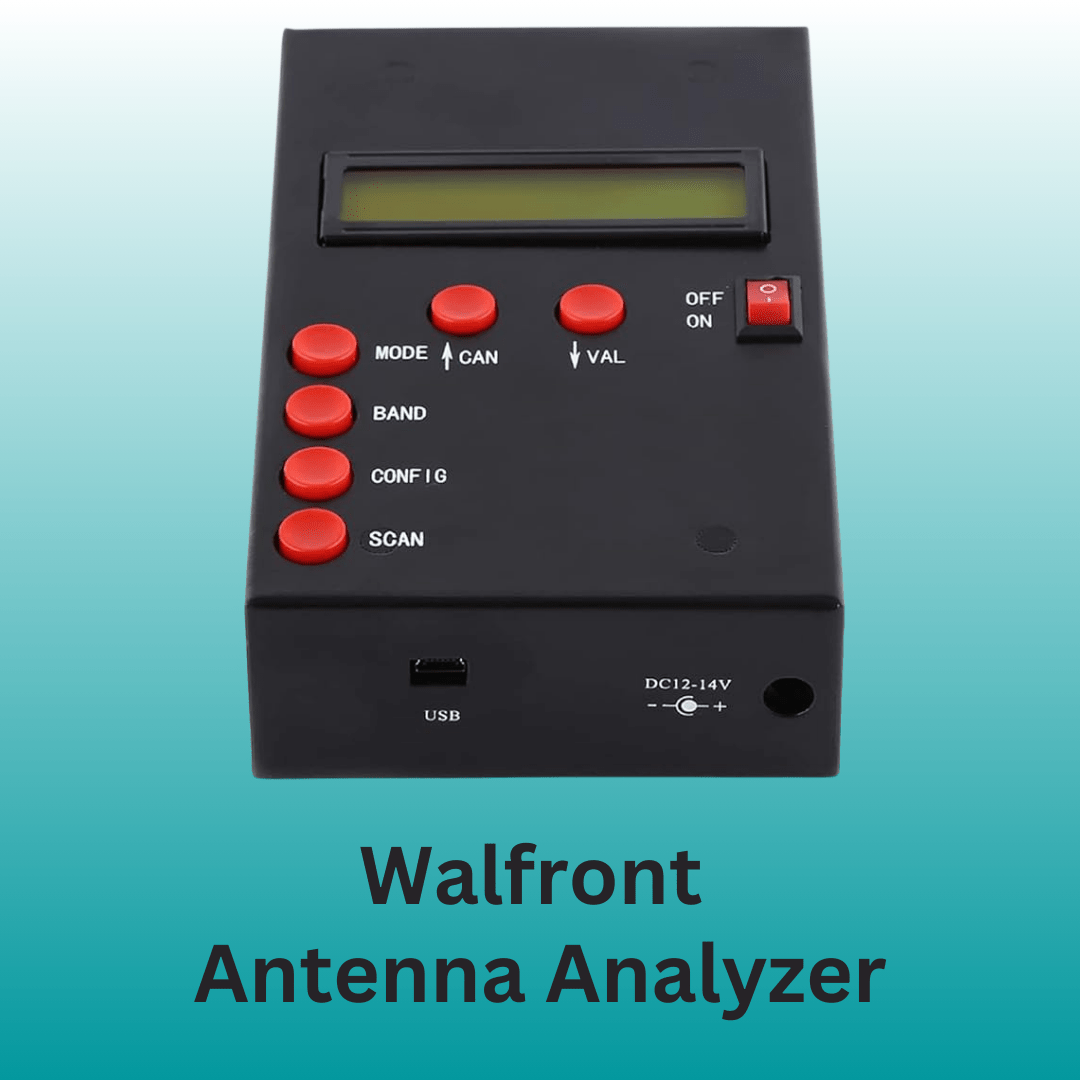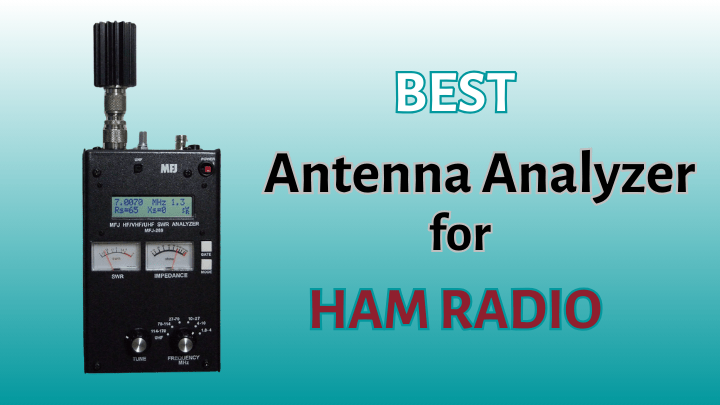Maintaining optimal antenna performance is very important for every ham radio enthusiast. Whether you’re a pro operator or just starting out, having the right tools to fine-tune your antenna system can significantly improve your communication range, clarity, and overall experience.
Antenna Analyzers and SWR meters are terms that you must have come across during your radioing journey. These are amongst two necessary equipment you will need for optimizing your station.
This Article however will primarily focus on Antenna Analyzers, it’s working and “Best Antenna Analyzer for Ham Radio”. So let’s get moving with it.
Best Antenna Analyzer: What is an Antenna Analyzer?
What is an Antenna Analyzer?
An antenna analyzer is a versatile tool designed to measure and analyze the performance of your antenna and feedline system and looks something like in image shown. It works by sending a signal through the antenna and measuring various parameters that are listed below:

1. Impedance:
This indicates how efficiently your antenna transmits and receives RF signals. An ideal match results in zero impedance, meaning all power is transferred from the transmitter to the antenna and vice versa.
2. Standing Wave Ratio (SWR):
This measures the mismatch between your antenna and feedline, with a lower SWR indicating better performance.
3. Return Loss:
This shows how much power reflects back from the antenna towards the transmitter, with higher values indicating better matching.
4. Resonant Frequency:
This identifies the frequency at which your antenna performs optimally for a specific band.
Best Antenna Analyzer: Bestsellers List for Quick Reference
If you are short of time and want to choose one right away, here is a quick reference table of Best selling Antenna Analyzers to help you with choosing one:
No products found.
Best Antenna Analyzer: Difference between Antenna Analyzer and SWR meter
Even if the working still sounds like SWR meter, An Antenna Analyzer is different from SWR meter.
SWR Meters
An SWR meter will provide basic measure of mismatch between transceiver and the antenna line. They sometime comes inbuilt with the radio and you can adjust antenna length according to reading of the mismatch.
No products found.
Antenna Analyzers
On the other hand an Antenna Analyzer offers a deeper understanding of your antenna’s characteristics. It measures Active and Passive (Resistive & Reactive) elements at a minimum.
It will let you modify the design of your antenna right at the feed point itself without connecting it to the radio or tranceiver and gives you instant feedback if you need to lengthen or shorten the elements. So basically you don’t have to climb to the antenna every time you take readings.
No products found.
Some high-end models of Antenna Analyzers will have functions like graphs, smith-charts, frequency sweep, 1/4 & 1/2 wave stubs and even software to run and save configurations on PCs.
This allows you to diagnose issues, optimize performance, and experiment with different antenna designs for improved communication.
Best Antenna Analyzer: Why do Hams Need it?
Here are some key reasons, why having an antenna analyzer is beneficial for Ham radio operators:
1. Fine-tuning:
Precisely adjust your antenna for optimal performance on specific frequencies, leading to stronger signals and better communication range.
2. Troubleshooting:
Quickly identify and diagnose issues like feedline damage, improper connection points, or antenna design flaws.
3. Experimentation:
Build and test new antenna designs with confidence, understanding how each modification affects their performance.
4. Convenience:
Eliminate the need for multiple measurements and calculations, providing a streamlined process for antenna optimization.
While SWR meters offer basic insight, antenna analyzers provide a comprehensive picture, ultimately saving time and effort in achieving optimal antenna performance.
Best Antenna Analyzer: How to Choose one?
With numerous antenna analyzers available in the US market, selecting the right one can be overwhelming. Here are some key factors to consider:
1. Frequency Range:
Ensure the analyzer covers the frequency bands you operate in, most commonly HF, VHF, and UHF for Ham radio.
2. Accuracy:
Higher accuracy provides more reliable measurements, especially for critical adjustments.
3. Features:
Consider additional features like sweep measurements, smith chart displays, and data storage capabilities based on your needs.
4.Portability:
Choose between handheld units for field use or benchtop models for more advanced analysis.
5.Budget:
Analyzers range in price, so choose one that fits your budget while offering the necessary features.
Best Antenna Analyzer: Recommended Analyzer
Our recommended Antenna Analyzer is Walfront av2nf169gr.

- Brand: Walfront
- Model: av2nf169gr
- Color: Black
- Impedance: 50Ohms
- Maximum Range: 60 Meters
The Walfront Antenna Analyzer Meter with a 1-60MHz Shortwave SWR usable measurement range for Ham radio enthusiasts.
Summary of features:
- Durable Protection: Black case shields the analyzer from damage, ensuring long-lasting use.
- Easy Operation: 5 clear buttons simplify navigating modes, bands, and functions.
- Portable Design: Compact size and external power (DC 12-14V) make it convenient for field use.
- Wide Measurement Range: SWR measurements from 1.0 to 9.99, with configurable step sizes (100Hz, 1KHz, 10KHz, 100KHz).
- Versatile Analysis: Measures antenna parameters (SWR, impedance, capacitance, inductance), feed-point impedance, ground loss, inductors, capacitors, and more.
- Tuning Assistance: Analyzes SWR, Q, resonant frequency, bandwidth, impedance for optimal stub tuning.
- Additional Features: Measures coaxial cable loss, evaluates antenna tuner loss, and estimates quartz crystal parameters.
Best Antenna Analyzer: Conclusion
Investing in a quality antenna analyzer is a worthwhile decision for any Ham radio enthusiast who wants to maximize their communication potential.
By understanding your antenna’s performance and making informed adjustments, you can enjoy reliable, clear, and powerful communication across various bands. Consider your specific needs, budget, and desired features when selecting the Best Antenna Analyzer for your radio adventures.
Best Antenna Analyzer: FAQs
If I already have an SWR meter, do I still need an antenna analyzer?
While an SWR meter provides basic mismatch information, an antenna analyzer offers a deeper understanding of your antenna’s characteristics, including impedance, resonant frequency, and return loss. This allows for more precise fine-tuning and troubleshooting beyond just identifying a mismatch.
Can I use an antenna analyzer to repair damaged antennas?
While an analyzer can help identify issues like feedline damage or improper connections, repairing actual physical damage may require additional tools and soldering skills. Consult experienced ham radio operators or antenna specialists for complex repairs.
Are there any legal considerations when using an antenna analyzer?
Always ensure your antenna system complies with FCC regulations regarding antenna height, power limits, and frequency bands. Some advanced analyzers with signal generation capabilities might require specific licenses depending on their functionalities.

